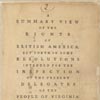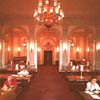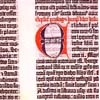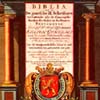
Introduction
The Rare Book and Special Collections Division traces its beginnings to Thomas Jefferson's wish to create a library for statesmen and for the people of the new nation. After the British burned the Capitol and its library in 1814, Jefferson offered to sell his book collection to Congress. Congress appropriated money for the purchase, and Jefferson's collection served as the foundation for the new Library of Congress in 1815. Jefferson's books--in several languages and covering a great variety of subjects--today form the nucleus of the division.

|
Attributed to Thomas Jefferson. A Summary View of the Rights of British America (1774). This book was an early argument for the separation of the colonies from Great Britain. This copy is signed and annotated by Jefferson. (Thomas Jefferson Collection) |
Although at first the Library did not create a separate Rare Book Division, Ainsworth Rand Spofford, Librarian of Congress from 1864 to 1897, gathered in his office rare books, pamphlets, broadsides, and printed ephemera of interest to the scholars of his day. The institution also actively sought out collections that contained rare materials. In 1867 the Library of Congress purchased the large private library of Peter Force and in 1906 bought the Russian collection of Gennadii Yudin. Gifts from many generous donors also added greatly to the rare holdings. Joseph Meredith Toner in 1882 made the first gift to the nation of a large library--about 43,000 books, pamphlets, scrapbooks, and bound periodicals on American history, the history of medicine, and other subjects. In 1925 the Library received the John Boyd Thacher Collection consisting of rare examples of early printing, autographs of notable Europeans, and a sizable gathering of material on the French Revolution. By the time of the Thacher gift the Library's considerable number of rare books necessitated the creation of a special section to house and to care for them. In 1934 the division moved into its present reading room and stack area.

|
Reading Room of the Rare Book and Special Collections Division. (Photograph by Reid Baker) |
In 1930 Congress authorized the purchase of 3,000 fifteenth-century books owned by Otto H. Vollbehr, including one of three known perfect copies of the Gutenberg Bible printed on vellum. From 1943 to 1979 the munificent rare book donor Lessing J. Rosenwald presented to the Library a collection of 2,600 rare illustrated books that constitutes the finest gathering of rare books in the Library of Congress.

|
Biblia latina (Mainz: Johann Gutenberg, 1454-55). The first book printed with movable type. The Library's copy is one of three known complete copies printed on vellum. (Vollbehr Collection) |
Today the division's collections amount to approximately 650,000 books, broadsides, pamphlets, theater playbills, title pages, prints, posters, photographs, and medieval and Renaissance manuscripts. Although the division's materials have come into its custody for a variety of reasons--their monetary value, importance in the history of printing, binding, association interest, or fragility--they have one point in common: the collections offer scholarly documentation about the western and American traditions of life and learning.

|
Biblia. Dat is de gantsche H. Schrifture, vervattende alle de Canonijcke Boecken des Ouden en des Nieuwen Testaments (Amsterdam, 1702). This Dutch Bible has over 160 hand-colored illustrations by Romeyn de Hooghe, perhaps the most significant Dutch book illustrator of the late seventeenth and early eighteeenth centuries. |
The division's holdings encompass nearly all eras and subjects, with a multitude of strengths. The collection of nearly 5,700 incunabula (fifteenth-century imprints) is the largest such grouping in the western hemisphere. Americana dates from the Columbus letter (1493) to the present and includes more than 16,000 imprints from 1640 to 1800, extensive holdings of western Americana, Confederate States publications, and thousands of nineteenth-century pamphlets.
The division maintains well over 100 separate collections which are listed in the appendix to this guide. The following serve as examples: personal libraries (Thomas Jefferson, Woodrow Wilson, Theodore Roosevelt, Susan B. Anthony, Oliver Wendell Holmes, Frederic W. Goudy, and Harry Houdini); comprehensive author collections (Walt Whitman, Henry James, Sigmund Freud, Rudyard Kipling, Benjamin Franklin, and Hans Christian Andersen); subject collections (magic, gastronomy, cryptography, radical literature, papermaking, Sir Francis Drake, and the French Revolution); language (early Russian, Bulgarian, and Hawaiian imprints); the illustrated book (the Lessing J. Rosenwald Collection, artists' books); collections with unusual provenance (Russian Imperial and Third Reich Collections); and generic collections (miniature books, artists' books, Bibles, American children's books, broadsides, theater playbills, pre-1871 copyright records, documents of the first fourteen Congresses, and dime novels).
In addition to these special groupings, the general or classified collection--about one-third of the holdings--reflects the division's strengths and contains at least a few books about virtually every subject that the Library of Congress as a whole collects. This guide describes many of these collections, and the appendix lists all the special holdings. The researcher will find records for only a portion of the division's holdings in the Library's computerized catalog. The division's central card catalog contains over 650,000 cards, providing access to almost all of its collections by author or other form of main entry and in some instances by subject and title as well. Additionally, more than 100 special card files describe individual collections or special aspects of books from many collections not available in the regular catalogs--for instance, by date, place, and printer for books from the early years of printing (before 1521 for European books, before 1641 for books in English or printed in Great Britain, before 1801 for American imprints, and before 1820 for Spanish American imprints), by former owner, by press (for modern fine printing), or by association interest. Printed catalogs provide access to individual special collections or have been annotated to indicate the division's holdings.
The division has always depended on the generosity of donors to create collections which have national and international stature. Lessing J. Rosenwald made it clear in his 1947 letter to Librarian of Congress Luther Evans that "The National Library deserves and demands the strongest rare book collection that it can possibly build." The donation of material, a vital part of our collecting operation, builds on existing strength and also charts new scholarly directions. Special funds, such as the Lessing J. Rosenwald Fund, the Margaret W. Winkelman Fund for Illustrated Books, and the Alfred Whital Stern Fund for Lincolniana, make a considerable impact on the growth of the division by developing collections and advancing scholarship using these rich resources.
![Thumbnail image of "Apocalypsis Sancti Johannis" [Germany, ca. 1470]](rat12001.jpg)
|
Apocalypsis Sancti Johannis [Germany, ca. 1470]. Brilliantly colored block book, one of ten examples of xylographic printing in the Rosenwald Collection. (Lessing J. Rosenwald Collection) |
The division's permanent reading room, modeled after Philadelphia's Independence Hall, houses the divisional catalogs, reference collection, and reference staff. The reading room is located in the Thomas Jefferson Building, room 206. Across the hall is the division's Lessing J. Rosenwald Room.
![Thumbnail image of Lessing J. Rosenwald Room of the Rare Book and Special Collections Division]](rat57001.jpg)
|
Lessing J. Rosenwald Room of the Rare Book and Special Collections Division. |
Current and former staff members James Gilreath, F. Thomas Noonan, Rosemary Fry Plakas, Robert R. Shields, Larry Sullivan, and Peter Van-Wingen contributed sections to this guide.
Mark Dimunation, Chief
Rare Book and Special Collections Division
Rare Book and Special Collections in American Memory
Library of Congress Home Page
 Library of Congress
Library of Congress